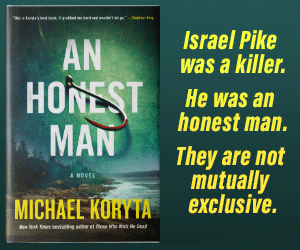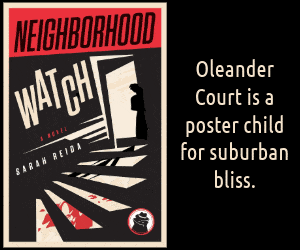 The first Maureen Coughlin novel, The Devil She Knows, was supposed to be the end, not the beginning. It was my third Staten Island novel. It put a neat cap on a crime fiction trilogy about where I grew up, and finally gave a novel to a character I had carried and worked with for a long time. That is until late one night when Maureen, while watching the cops parked on her mother’s street, decided, “I can do that. That’s what I want to do.” She changed not only the direction of her life, but the direction of my writing life. I’d leave Staten Island, as I had planned, and move my writing like I had my life to New Orleans, only now Maureen was coming along. Easy, right?
The first Maureen Coughlin novel, The Devil She Knows, was supposed to be the end, not the beginning. It was my third Staten Island novel. It put a neat cap on a crime fiction trilogy about where I grew up, and finally gave a novel to a character I had carried and worked with for a long time. That is until late one night when Maureen, while watching the cops parked on her mother’s street, decided, “I can do that. That’s what I want to do.” She changed not only the direction of her life, but the direction of my writing life. I’d leave Staten Island, as I had planned, and move my writing like I had my life to New Orleans, only now Maureen was coming along. Easy, right?
I knew that Maureen’s career choice gave me a chance at writing a character-driven crime series, something, despite being a big fan of the form, I hadn’t planned on doing. Or maybe attempting at some indistinct point in the future. But suddenly, like love, it was happening anyway, and happening now, and it felt good, so I thought, why fight it? I had a character, a set-up. All I needed was a setting. Could I do better than New Orleans? Still, I hesitated, surprising myself. Should Maureen stay in New York? Be a cop there? Weird. When it came time to depart for New Orleans in real life, I couldn’t blow town fast enough. Despite most of my family staying close to our New York roots, and despite my enduring attachment to the New York Mets, New Orleans immediately felt like home, indeed became my home in soul and spirit and football fandom not long after my arrival in 1997. It never felt more like home than during my six weeks in exile after Katrina.
In 2011, when I started The Devil in Her Way, I hadn’t lived on Staten Island in twenty years, hadn’t lived in the New York City area in almost fifteen. Yet the first scene I ever wrote with Maureen as a cop was set in NY. It was a good scene. But I had trouble coming up with more. I didn’t know where she should go next. I considered a story that moved back and forth between New York and New Orleans. I rewrote that first scene with Maureen as a tourist in New Orleans instead of a cop. Meh. I talked to my agent; he didn’t like the idea. Make the move, he suggested, take the leap and set the new book in New Orleans. Let go of New York. I moved the scene from an imaginary Brooklyn street corner to a New Orleans corner. The scene jumped to life: the smells and sounds, the heat and humidity, the voices of the people in the street. Suddenly it was real. A neighborhood watchdog poked her head out of her front door. Three neighborhood kids walked into the scene, one of them dropped a name to Maureen, and the book took off. Later, as I filled in the backstory of her decision to join the NOPD and her move to the city, one line echoed in my head: “Somewhere else she could be someone else.”
Writing about a newcomer to New Orleans was enormous fun. I got to revisit the mind of a fresh transplant. I vividly recalled my wonder at a place where palm trees swayed in the breeze year round with parakeets perched in their fronts, at the stop-you-in-your-tracks scents of night-blooming jasmine and sweet olive, the incredible food and music, with the slow, slow pace, and with the often shocking violence, the casual racism, and the decidedly Third World bent of the local politics. And the heat. Lord. Having been here a while, I also got to inhabit the mind of Maureen’s NOPD training officer, Preacher Boyd, who knows the city and attempts teaching and explaining the unique ways the city works, and the ways it doesn’t work, and how it never ceases to surprise even its most jaded veterans.
Despite its famous nickname, New Orleans is not an easy place to live, or love, nor is it an easy place to write about. Its essence defies explanation and eludes capture. It distracts with sensual temptations—another drink, another meal, another cup of coffee, another show, another hour strolling along the bayou under the stars—and with easy to reach for clichés disguised as truth. A writer can not only get distracted, but intimidated into paralysis, as happened to me, just trying to describe the many shades of green produced by the sunset light through the live oaks along St. Charles Avenue. That’s before you get to the symphony of accents and inflections overheard in a single conversation. Fortunately, freedom arrived in great advice from my wife. “Stop trying to write the book about New Orleans,” she said, “and just write a book about New Orleans. Participate in the conversation.” Great advice and more proof that I needed to be writing a series. One of New Orleans’ many gifts is no shortage of material.
 I’ve written all of my novels in New Orleans. Not long after I got here, I tried writing a novel set in Louisiana, which went nowhere until I reset it on Staten Island. Fifteen years later, my latest novel stalled until I moved it off Staten Island and reset it in New Orleans. Maybe now, long after I thought I’d arrived, I’m home.
I’ve written all of my novels in New Orleans. Not long after I got here, I tried writing a novel set in Louisiana, which went nowhere until I reset it on Staten Island. Fifteen years later, my latest novel stalled until I moved it off Staten Island and reset it in New Orleans. Maybe now, long after I thought I’d arrived, I’m home.
Bill Loehfelm is the author of The Devil She Knows, Bloodroot, and Fresh Kills. His most recent novel is The Devil In Her Way. He lives in New Orleans with his wife, the writer AC Lambeth, and plays drums in the Ibervillains, a rock-and-soul cover band.





